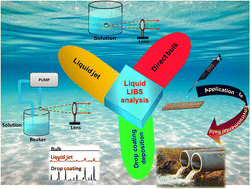Optimization of different sampling approaches in liquid LIBS analysis for environmental applications†
Abstract
Laser-induced breakdown spectroscopy (LIBS) has aroused increasing interest in analytical chemistry, and biomedical and environmental fields due to its multi- and trace elemental analysis and real-time monitoring capability. However, LIBS studies on liquid samples often suffered from splashing and a shorter plasma lifetime in a liquid environment that impede the detection of ultra-low concentration samples. The important challenge in the ongoing LIBS application is to improve the limit of detection (LOD) from ppm to ultra-low concentration (ppb and ppt) levels, particularly for liquid sample analysis. In the present work, we have compared three different sampling approaches for trace elemental detection in aqueous samples: (i) direct bulk liquid, (ii) liquid jet, and (iii) solid residue on substrate. The analysis of the results elucidates that highly sensitive and reproducible LIBS spectra can be obtained using the solid residue on substrate. Undeniably, our solid residue on substrate results, though not in situ, established excellent reproducibility with a low limit of detection and it may be applicable for trace level elemental detection in environmental liquid samples. The potential of the approach is demonstrated by investigating the presence and bioaccumulation of trace elements in water samples from the River Swarna, southwest coast of India. The present study demonstrates that the solid residue on substrate is more advantageous in investigating environmental applications with a sample volume as small as 10 μL in a single laser-pulse experiment. These findings are particularly motivating given the application of the LIBS technique in investigating trace elements in natural samples in field applications.



 Please wait while we load your content...
Please wait while we load your content...